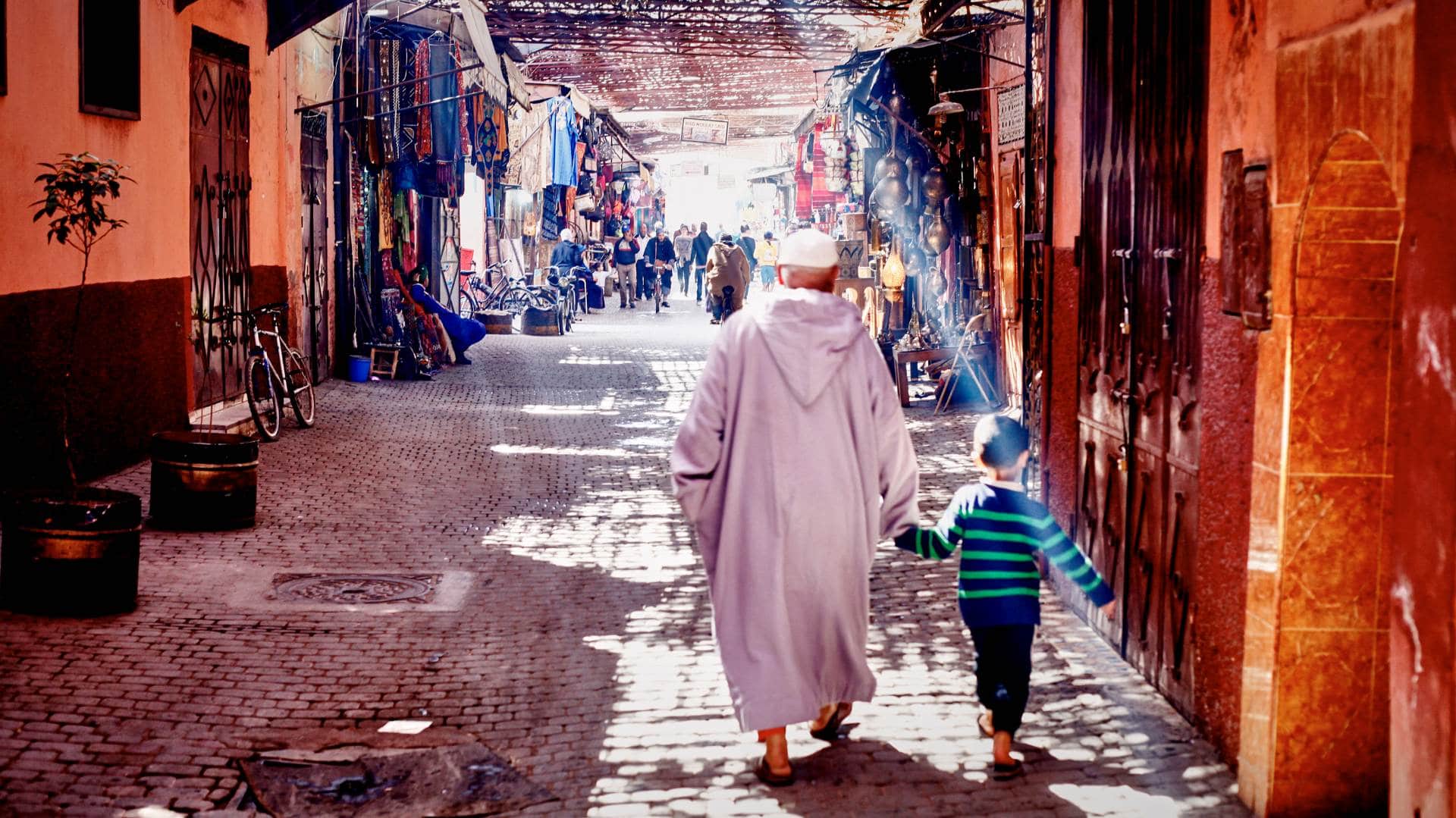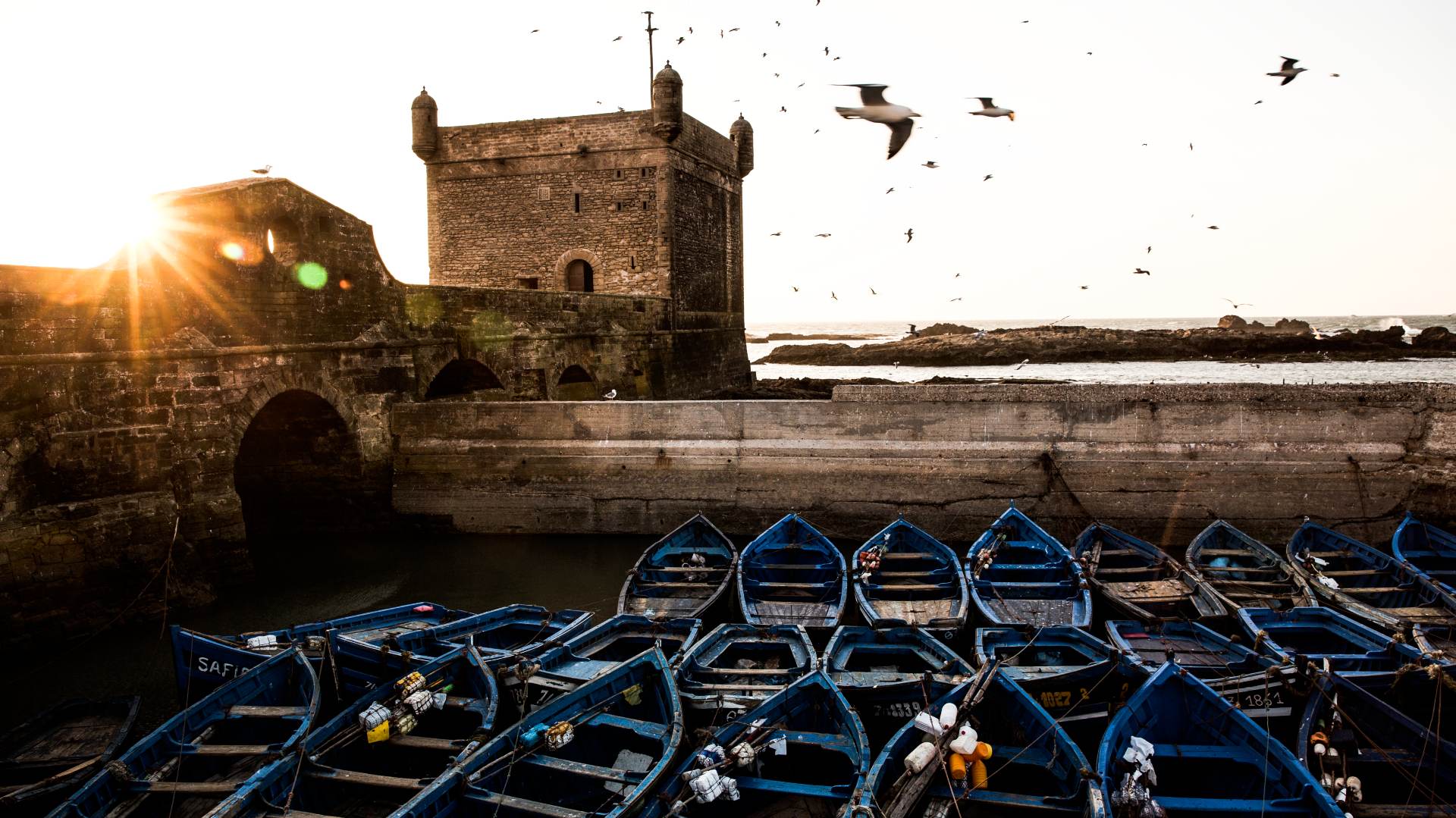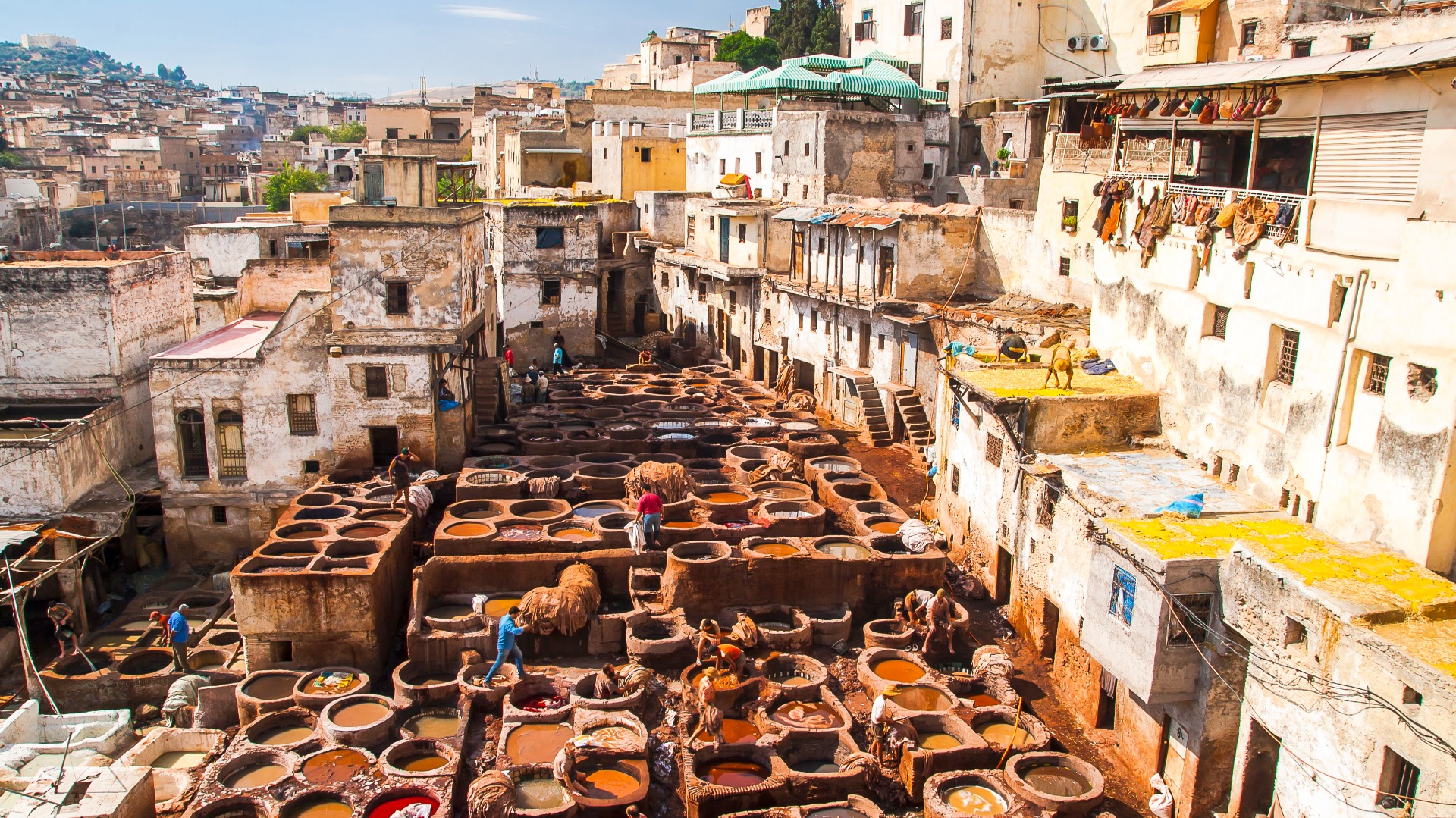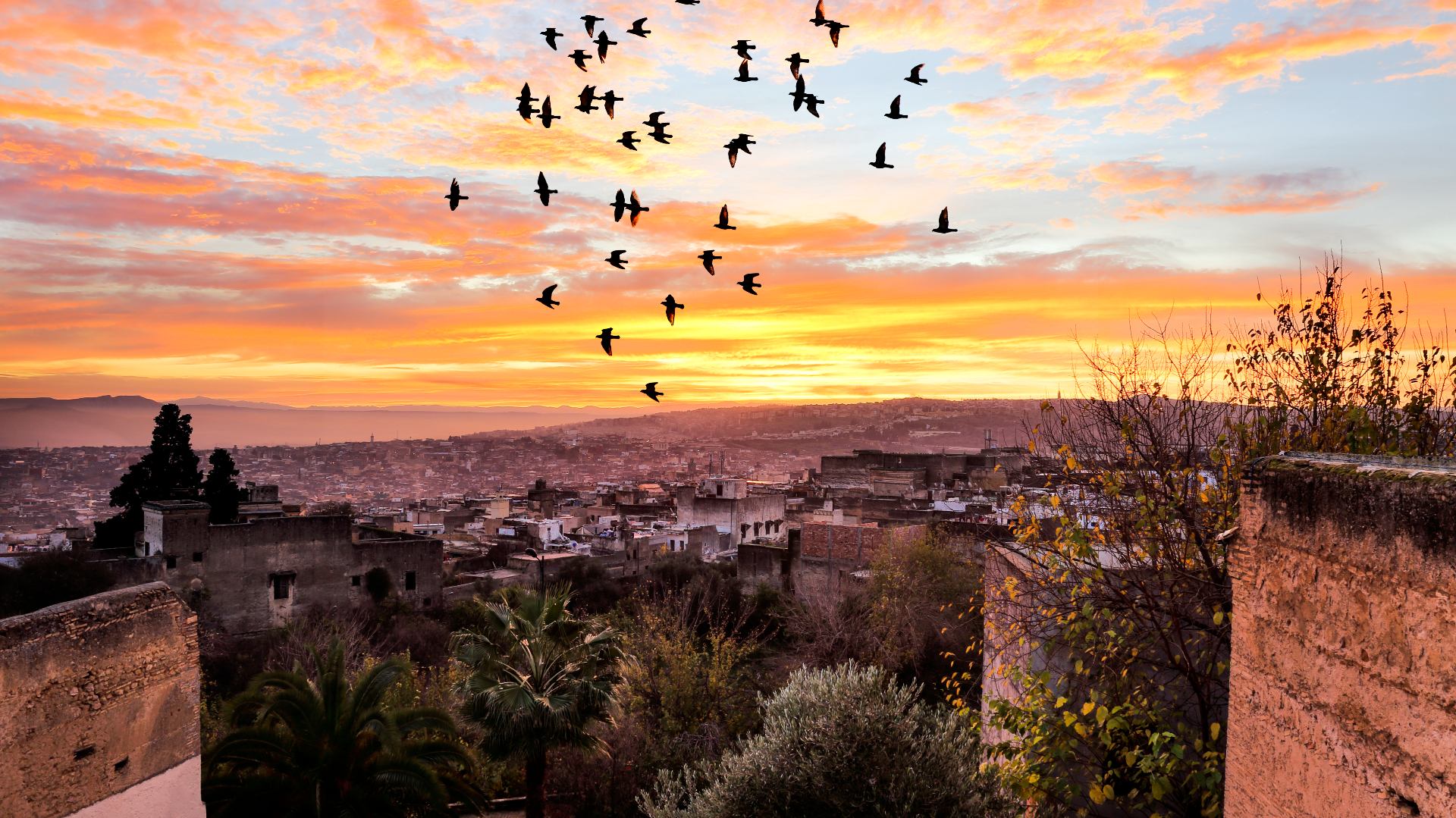With one foot in the Sahara desert, where the guides speak Berber during camel treks in the cinnamon-hued dunes, and the other one dipping between the Mediterranean Sea and the Atlantic Ocean (where French and Spanish flow as easily as Moroccan Arabic), Morocco is full of surprises.
The best way to experience this fascinating North African country is on a road trip between Marrakech and Fez, two of Morocco’s most storied cities. Spending your holiday driving through extraordinary cities and towns is guaranteed to be an unforgettable experience.
Local’s Tip: Never turn down an invitation to drink mint tea with a Moroccan. Sure, it may be an opener for selling you a carpet — but you can always say no to the rug. Pass on mint tea, however, and you’ll miss out on a beloved ritual of Moroccan life.
As always, check for travel guidelines and closures before planning your trip.
Days 1 and 2: Marrakech
Popular with Europeans for weekend trips or as a launching point for a Morocco-wide adventure for those with more time, Marrakech is a cosmopolitan city with a timeless soul.
The warren of narrow streets in the sprawling, red-walled medina (old city) are a UNESCO World Heritage Site where you could easily while away an entire day getting lost doing last-minute shopping for spices and handmade home decor in the souks, listening to the sound of the call to prayer rising from the spectacular Koutoubia Mosque and visiting the many important historical sites.

When your senses need a break from all the input, escape to the rooftop at Nomad, a stylish restaurant inside a former carpet shop in the medina where you can chill with views of the snow-topped Atlas Mountains and sample the “revisited” Moroccan menu, with dishes like sardine tarts and Moroccan gazpacho spiked with fresh ginger.
One of the most Instagrammable spots in town — particularly when the skies are their usual blinding blue — is the Jardin Majorelle, a botanical garden brimming with cacti, bougainvillea and palms built in the 1920s by French artist Jacques Majorelle and later restored by Yves Saint Laurent.
Come sunset, the huge square called Jemaa el-Fna is the place to be to stroll past scores of food stalls (look for crowds gathered for a bowl of harira soup — spiked with chickpeas, it’s a hearty winter warm up), catch a snake charmer show or have your fortune told.
Don’t leave Marrakech without taking to the waters the traditional Moroccan way in the form of the steam bath ritual called “hammam.” Hammams are bathhouses found in every neighborhood in the medina — and there are many luxury ones geared toward tourists in Marrakech. (Note: Many are closed for now due to Covid). For a modern setting to try a private hammam experience, book in for a gommage (body scrub) at the spa at Le Méridien N’Fis, where other treatments include hot stone or deep tissue massage.
Day 3: Essaouira (or the Desert)
Today, take a day trip from Marrakech on your choice of a coastal or desert adventure.
Arguably Morocco’s most beautiful coastal town and another UNESCO World Heritage Site, Essaouira is worth waking up early for. It takes just under three hours along the R207 to make the drive west 115 miles from Marrakech, so get an early start.
Once you feel the cool, salty Atlantic Ocean breeze in your hair and settle in for a meal of fresh sardines at one of the open-air stalls near the fishing port (they’re all the same, so pick whichever calls out to you), you’ll be glad you came.

In contrast to Marrakech’s rusty red tones, Essaouira, which was a hippie hangout in the 1960s and still beats to its own drum, is painted in bright shades of blue and white.
Just strolling the breezy streets — full of shops selling the usual Moroccan leather and ceramic wares — alongside vacationing Moroccans and admiring the Atlantic Ocean from the city ramparts is a down-to-earth pleasure to remember.
Closer to Marrakech, the Agafay Desert Camp is just 22 miles (35 kilometers) southwest of the city and offers visitors the chance to ride a camel or go on quad-biking adventures in the surrounding desert. The Sahara it’s not (those big desert dunes you see on postcards are a full-day drive east), but you’ll still get the feel for a stony desert landscape while soaking up views of the snowy High Atlas Mountains.
Day 4: Casablanca, Meknes and Fez
It’s a big driving day to get from Marrakech to Fez, some 330 miles (531 kilometers) northeast (or just under six hours, if you do it in one go). The route follows highways the entire way, passing through several cities, including Casablanca and Meknes, that you may consider stopping in to break up the trip.
Roughly 2.5 hours after leaving Marrakech you’ll arrive in Casablanca, Morocco’s economic and business center, if not its political capital (that would be Rabat).
The Morocco Mall is one of Africa’s largest shopping malls and has free parking and just about every luxury and chain international shop you can imagine (but did you really come to Morocco for that?).
For something more quintessentially Moroccan, opt to stop in the compact medina of Meknes instead, another 150 miles along the highway from Casablanca toward Fez, where the souk vendors selling babouches and carpets tend to be more relaxed than in the bigger cities.
Arrive in Fez in time for a cocktail at the jaw-dropping rooftop bar at Riad Fes, with views over the medina’s crumbling buildings that glow golden at sunset, as the call to prayer rises from the countless mosques below.
Days 5 and 6: Fez
Arguably the most transporting medina in all of Morocco, Fez’s old walled city, accessed by the grand gate at Bab Bou Jeloud and other points, cascades mazelike downhill, past tiny jewelry shops, hammams, stalls selling religious relics, vendors hawking camel meat and much, much more.

You can spend a whole day just making your way through the medina’s moveable feast of sights and sounds to the famous mosque and university at its heart, al-Qarawiyyin, that dates to 859 A.D.
Into shopping for handmade leather goods? Follow your nose to the tanneries (or better yet, pay someone a couple dirham to guide you there) deep inside the media, where you can watch the process of leather being softened and dyed before it’s fashioned into handmade jackets, bags, purses and belts for sale in shops overlooking the dying vats.
Chouara Tannery has a huge selection, but you’ll find many smaller shops selling leather goods here, too, and if you don’t see exactly the color or style you’re looking for, just ask; chances are someone can chase it down for you.
By now you might be hooked on Moroccan food, so why not pause from the sightseeing for a cooking class with Cafe Clock, where the day’s multicourse menu could see you preparing a vegetarian couscous or lamb tajine with dates and prunes before digging in to feast. Moroccans start every meal by saying “Bismillah,” which means “In the name of God,” and they love it when you follow suit.
Once you’ve had your fill of more medina sensory overload, an easy day trip from Fez takes you south 40 miles along winding mountain roads to the Middle Atlas mountain town of Ifrane.
Home to a unexpected Alpine-style architecture and a university that attracts international students, it’s been called the Switzerland of Morocco. During the winter, there’s usually snow at these altitudes, too.
And on a drive through the beautiful cedar forests in Ifrane National Park you might even see Barbary macaques (monkeys) frolicking along the side of the road just to remind you that you’re not in Kansas anymore.




